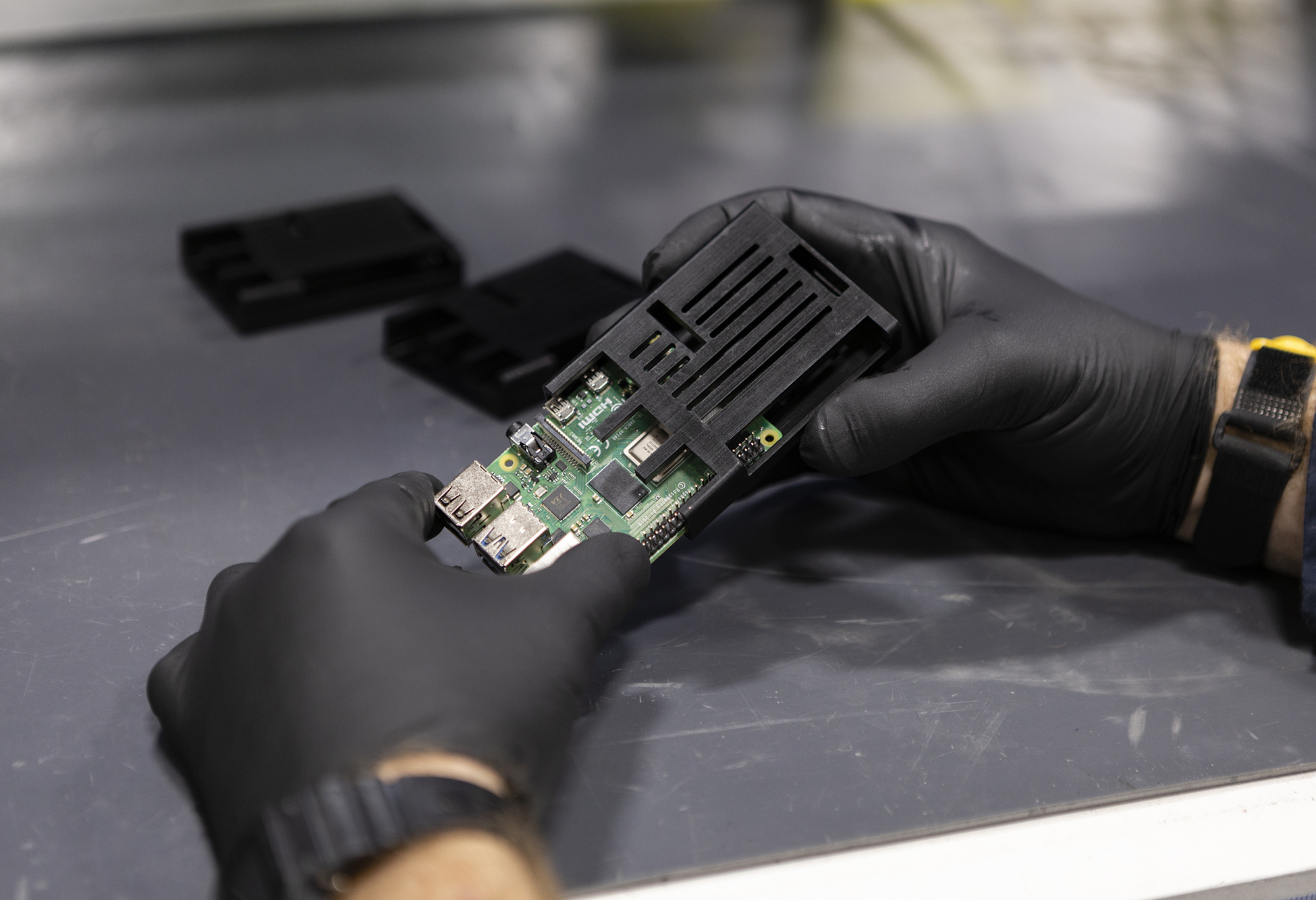Reducing risks in electronics production
Innovation is the be-all and end-all in the field of 3D printing. One of the most exciting developments in recent times is the introduction of the electrostatic dissipative resin xESD. This revolutionary material, combined with Nexa3D printers, helps electronics manufacturers reduce the risk of electrostatic discharge damage to production lines and sensitive components.
To find out more about the possibilities of printing ESD parts, I spoke to Dr. Olga Ivanova, Head of Applications and Technology at Mechnano, the leading manufacturer of electrostatic dissipative resin and Nexa3D partner for xESD.

Dr. Olga Ivanova is a researcher with more than 10 years of experience in additive manufacturing. Her research and development work in the field of additive manufacturing includes fused filament fabrication of textiles for the manufacture of military uniforms, the development of radiation-curable silicones for the manufacture of medical devices for newborns, the modification of pyrotechnic compositions for decoys so that they can be 3D printed, and much more.
Table of contents
- Q1: What is an electrostatic dissipative 3D printing resin and how does it differ from conventional 3D printing materials?
- Q2: What are the main advantages of using electrostatic dissipative 3D printing resins?
- Q3: Are there different types of ESD resin? How does the xESD resin from Mechnano and Nexa3D stand out on the market?
- Q4: Are there specific industries or applications where electrostatic dissipative 3D printing resins are particularly beneficial?
- Q5: Can you give any tips or advice for users who want to achieve the best results when 3D printing with Mechnano’s electrostatic dissipative resin? Are there things that customers should look out for when using a particular ESD resin?
- Q6: Do you have any examples of users who use xESD 3D printing resin?
Q1: What is an electrostatic dissipative 3D printing resin and how does it differ from conventional 3D printing materials?
The main difference between conventional 3D printing materials and static dissipative materials lies in their electrical properties. Polymers are insulators by nature, i.e. they are not able to conduct electricity. Electrostatic dissipative resins contain a conductive filler that facilitates the gradual dissipation of static charges into the ground, effectively preventing the build-up of static electricity.
Static charge in insulating parts can cause problems in various applications where the accumulation of static electricity and its abrupt release can be harmful and have a negative effect on electronic equipment, mechanical components and flammable materials.

Q2: What are the main advantages of using electrostatic dissipative 3D printing resins?
Electrostatic dissipative resins (ESD resins) have numerous advantages that make them very valuable in industries where the risk of static discharge is a major problem. Although ESD resins are relatively new, ESD thermoplastics (including filaments and powders) have been in use for some time. These thermoplastics are used extensively in applications where the occurrence of sparks could lead to catastrophic consequences, such as in vehicle fuel systems, in the oil and gas industry and in the manufacture of microchips and circuits for electronics.
In contrast to ESD filaments and powders, ESD resins are characterized by their exceptional ability to achieve a high degree of precision. The XiP Pro offers a resolution that rivals injection molding and precision machining. In addition, the resulting surface finish is exceptional, intricate part details can be reproduced with extreme finesse, and the production speed is higher than with conventional manufacturing processes.

Q3: Are there different types of ESD resin? How does the xESD resin from Mechnano and Nexa3D stand out on the market?
Yes, there are different types of ESD resins, but the key factor that sets them apart is the conductive filler they contain. The cheaper ESD resins on the market usually contain clumped carbon nanotubes (CNT). Although CNTs have impressive properties such as excellent strength and electrical conductivity, they tend to clump or form bundles during the manufacturing process. In this clumped state, the CNTs cannot fully transfer their extraordinary properties to the polymer. This results in a performance comparable to that of carbon black, but at a considerably higher cost.
The xESD resin from Mechnano and Nexa3D is characterized by the use of functionalized discrete carbon nanotubes (CNTs), which are evenly distributed in the resin without clumping. This ensures that each layer of a printed part contains a uniform amount of CNTs, regardless of the build orientation. This technology, known as “D’Func”, not only enables excellent ESD performance, but also improves mechanical properties such as tensile strength, impact strength and yield strength.
Q4: Are there specific industries or applications where electrostatic dissipative 3D printing resins are particularly beneficial?
Certainly. The electronics industry is a prime example of a sector that benefits significantly from the use of ESD resins. In this area, compliance with ESD standards is of crucial importance. As integrated circuits and microchips are very sensitive, even the slightest static discharge can cause serious damage to the components. Therefore, numerous precautions are taken to avoid any static electricity. These measures include the use of ESD-compliant shoes, earthed desks and ionized air.
With the increasing use of these components in various industries, including communications, transportation, defense, aerospace, consumer electronics and medical devices, the demand for ESD-compliant parts is growing. Until now, manufacturers had to resort to static dissipative, machined or compression-molded parts for various applications, which led to long lead times and exorbitant costs. xESD-Resin, used in conjunction with the XiP Pro, effectively solves this challenge by enabling the rapid production of ESD-compliant parts. This solution is proving to be extremely advantageous for the development of new products or the production of small batches, as it effectively eliminates the disadvantages of previous methods.
Q5: Can you give any tips or advice for users who want to achieve the best results when 3D printing with Mechnano’s electrostatic dissipative resin? Are there things that customers should look out for when using a particular ESD resin?
Tip No. 1: Be sure to read the Nexa3D Design Guide before you start designing and building the parts. This will help you to optimize production speed and improve the quality of the parts to ensure the best possible result.
Tip no. 2: The inclusion of CNTs in the xESD resin leads to increased viscosity. This increased viscosity can pose a challenge when removing excess resin from parts with blind holes, hollow chambers or internal channels during the washing process. In such cases, we recommend using short ultrasonic bath cycles to effectively rinse out trapped resin.
Tip No. 3: Post-curing thin, flat parts can lead to deformation or warping, which is undesirable. We therefore strongly recommend ribbing or restricting the part during the post-curing process.
Tip #4: Discrete and functionalized CNTs integrated in xESD ensure uniform and stable dispersion. Caution is advised when using alternative ESD resins, as agglomeration and sedimentation of the CNTs in the tank can occur.
Tip #5: If you need support, do not hesitate to contact Nexa3D support. They have extensive knowledge of the use of xESD resins, which can help minimize risks, and they are available to help resolve any issues.
Q6: Do you have any examples of users who use xESD 3D printing resin?
There are many examples of this. One case that immediately comes to mind is that of a customer who needed precise ESD auto-sorting pallets for handling fragile crystal resonators. These resonators varied in size and ranged from 8 mm x 4 mm to just 1.6 mm x 1.0 mm. The pallets were equipped with 150-400 micro-pockets and required uniform pocket depths of 80 micrometers. In particular, the corner holes on these pallets were so tiny that they are imperceptible to the human eye.
The customer’s initial trial of filament-based systems and cheaper ESD resin on the Formlabs Form3+ and filament options did not produce the desired result. However, switching to xESD resin on the XiP desktop 3D printer led to amazing results. The company was able to replace the expensive and time-consuming processing of ESD pallets made of black Radel, which cost 700 dollars each, with efficient in-house production overnight. This change significantly reduced costs and allowed the company to rework designs to produce high quality prototypes for production.

In summary, it can be said that xESD resin, together with XiP and XiP Pro, is changing the 3D printing landscape. It offers unparalleled electrostatic discharge (ESD) performance, exceptional precision and fast production capabilities. Industries such as electronics manufacturing benefit greatly from this technology, as it enables faster and more cost-effective ESD-compliant solutions. The previous example of a customer experience serves as a prime illustration of the remarkable potential of xESD resin for high-precision applications. As the world of 3D printing continues to evolve, electrostatic dissipative resins are undoubtedly at the forefront of innovation.


